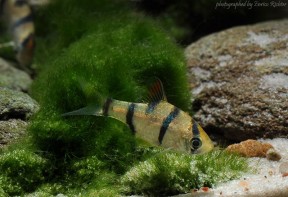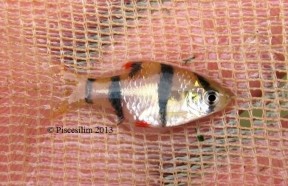Puntigrus partipentazona
SynonymsTop ↑
Barbus partipentazona Fowler 1934; Systomus partipentazona (Fowler 1934); Puntius partipentazona (Fowler 1934)
Etymology
Puntigrus: formed from part of the generic name Puntius and tigrus, a word created to sound like the Latin word tigris, meaning ‘tiger’, in allusion to the barred colour pattern and the common name ‘tiger barb’ used for some members.
partipentazona: from the Latin pars, meaning ‘part’, penta, meaning ‘five’, and zona, meaning ‘zone’, in reference to this species’ colour pattern.
Classification
Order: Cypriniformes Family: Cyprinidae
Distribution
Recorded from numerous river basins in Vietnam, Cambodia, Laos, Thailand, and Peninsular Malaysia, including the Mekong, Chao Phraya, Mae Khlong, Chanthaburi, Tapi, Golok, Terengganu, Pahang, Endau, and Muar.
Type locality is ‘Kratt, southeastern Siam’, which corresponds to modern-day Trat Province, Thailand.
Habitat
Typically found in heavily vegetated parts of rivers and sluggish streams, and also known to inhabit natural lakes. Records suggest it displays a preference for habitats in which algae and other phytoplankton is present in significant quantities.
In the Endau River system, Peninsular Malaysia, sympatric fishes include members of various genera including Brevibora, Crossocheilus, Cyclocheilichthys, Rasbora, Trigonopoma, Desmopuntius, Trigonostigma, Acanthopsoides, Pangio, Nanobagrus, Akysis, Doryichthys, Sphaerichthys, Brachygobius, and Pseudogobiopsis.
Maximum Standard Length
35 – 40 mm.
Aquarium SizeTop ↑
An aquarium measuring at least 80 ∗ 30 ∗ 30 cm is required.
Maintenance
Choice of décor is not especially critical though it should display better colouration in a well-decorated set-up. The addition of floating or overhanging vegetation and driftwood roots or branches also seems to be appreciated by members of this genus.
Water Conditions
Temperature: 20 – 26 °C
pH: 5.0 – 7.0
Hardness: 18 – 179 ppm
Diet
Probably an omnivore feeding primarily on insect larvae and zooplankton, also browsing plant material and organic detritus.
In the aquarium offer regular meals of small live and frozen foods such as chironomid larvae (bloodworm), Daphnia, and Artemia alongside good quality dried products.
Behaviour and CompatibilityTop ↑
This species is generally peaceful and an ideal resident of the well-researched community aquarium.
It is a gregarious species forming loose hierarchies, with rival males continually battling with each other for female attention and hierarchical position within the group. A group of at least 8-10 specimens should therefore be considered the minimum purchase.
Sexual Dimorphism
Adult males are slightly smaller, slimmer, and possess a more intense colour pattern than females.
Reproduction
Unrecorded.
NotesTop ↑
This species occasionally appears in the aquarium hobby, but the trade is largely reliant on commercially-produced ‘tiger barbs’ of questionable origin.
It is easily distinguished from congeners by its unique colour pattern in which the dark blotch on the dorsal-fin extends onto the body, covering 3-4 scale rows, sometimes with an additional dark marking beneath.
The genus Puntigrus was raised by Kottelat (2013) in order to accommodate a group of species formerly referred to as the ‘Puntius tetrazona group’. Other members are P. tetrazona, P. navjotsodhii, P. pulcher, and P. partipentazona, of which the first three are native to western, central, and eastern Borneo, respectively, and the latter to Indochina.
This assemblage is diagnosed by possession of a unique colour pattern comprising 4 black bars on a pale body, and black pigmentation on at least the basal half of the dorsal-fin. The anteriormost body bar passes through the eye, the second is anterior to the pelvic-fin base, the third is above the anal-fin and continues onto it, and the posteriormost is at the caudal-fin base.
The following combination of characters also aid in identification, although individually they are not unique to the genus: body rhomboid, deep; last simple dorsal-fin ray serrated posteriorly; rostral barbels absent; maxillary barbels present; lips smooth and thin, postlabial groove interrupted medially; lateral line complete or incomplete; 18–23 lateral line scales; 9½–10½ [5½/1/3–4½] scale rows between dorsal-fin origin and ventral midline anterior to pelvic-fin base; 12–14 circumpeduncular scale rows; 8–9 rakers on first gill arch.
The genus Puntius was previously viewed as a polyphyletic catch-all containing over 100 species, but this situation has been largely resolved since the turn of the century.
References
- Fowler, H. W. , 1934 - Proceedings of the Academy of Natural Sciences of Philadelphia v. 86: 335-352
Zoological results of the third De Schauensee Siamese Expedition, Part V.--Additional fishes. - Alfred, E. R., 1963 - Bulletin of the National Museum of Singapore 32: 135-142
Some Colourful Fishes of the Genus Puntius Hamilton. - Freyhof, J., D. V. Serov, and T. N. Nguyen, 2000 - Bonner Zoologische Beiträge 49(1-4): 93-99
A preliminary checklist of the freshwater fishes of the River Dong Nai, South Vietnam. - Kottelat, M., 1992 - Raffles Bulletin of Zoology 40(2): 187-192
The identity of Barbus johorensis Duncker, 1904 (Teleostei: Cyprinidae). - Kottelat, M., 2001 - WHT Publications, Colombo: 1-198
Fishes of Laos. - Kottelat, M., 2013 - Raffles Bulletin of Zoology Supplement 27: 1-663
The fishes of the inland waters of southeast Asia: a catalogue and core bibiography of the fishes known to occur in freshwaters, mangroves and estuaries. - Ng, H. H. and H-H. Tan, 1999 - Zoological Studies 38(3): 350-366
The fishes of the Endau drainage, Peninsular Malaysia with descriptions of two new species of catfishes (Teleostei: Akysidae, Bagridae). - Ng, H. H. and H-H. Tan, 2010 - Cosmos 6(1): 95-116
An Annotated Checklist of the Non-Native Freshwater Fish Species in the Reservoirs of Singapore. - Pethiyagoda, R., 2013 - Zootaxa 3646(2): 199
Haludaria, a replacement generic name for Dravidia (Teleostei: Cyprinidae). - Pethiyagoda, R., M. Meegaskumbura, and K. Maduwage, 2012 - Ichthyological Exploration of Freshwaters 23(1): 69-95
A synopsis of the South Asian fishes referred to Puntius (Pisces: Cyprinidae). - Rainboth, W. J., 1996 - FAO, Rome: 1-265
Fishes of the Cambodian Mekong. FAO Species Identification Field Guide for Fishery Purposes.







